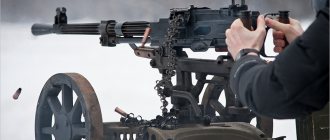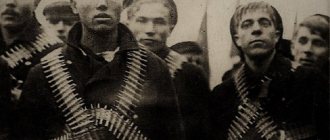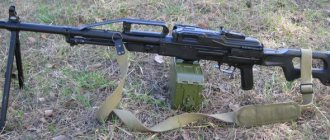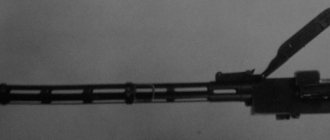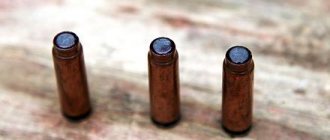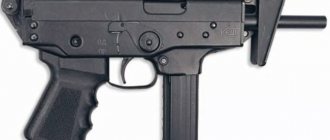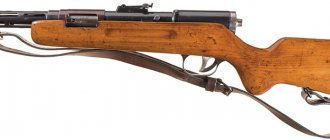Basis for a new light machine gun
During operation of the PCM, rapid overheating is observed. This forces you to take long breaks in use and replace the barrel. The RPK-74 light machine gun was designed for a 5.45 x 39 mm cartridge. This caliber is characterized by insufficient firepower. At the request of the military command, the Ministry of Defense announced the start of a competition to create a new, improved light machine gun, endowed with the advantages of PKM, characterized by heat resistance and increased lethality.
For this purpose, the 5.45 x 39 mm cartridges were replaced with others created specifically for the new weapon. It became the Badger machine gun - 7 62 54.
What did the changes affect?
- The barrel for the new machine gun was subject to modification. The developers managed to eliminate the main drawback of PCMs - rapid heating when firing. For this purpose, the production process used a steel alloy, which until that time had been used in the manufacture of guns for aviation.
- The mounting assembly of the receiver and barrel was changed. A longitudinal fin was installed on its surface, intended to serve as an improvised radiator, covered with a plastic forend. The use of fins prevents the barrel from quickly overheating. And this, in turn, eliminates the need for the fighter to interrupt firing to replace the barrel. The fins in the machine gun made it possible to significantly increase the length of the continuous burst of the AEK-999 “Badger”. Testing of the Kovrov machine gun indicates that the weapon, with slight heating, can fire up to 650 shots without replacing the barrel. When firing from machine guns, soldiers experience a “mirage” effect, which consists of distorting their view. This is due to hot air rising upward from the heated barrel. By using metal tires and fins installed on top of the barrel in the design, acting as a cooling radiator, the problem of visual distortion was solved.
- The gunsmith designers added a special shweiler above the upper part of the barrel, which made it possible to carry the AEK-999 machine gun not only by the handle. Fastening a metal channel to the barrel of a weapon made it easier to transport, and also gave the fighter the opportunity to fire a machine gun from the hip. Previously, this was difficult, since the weight of the AEK-999 “Badger” is more than eight kilograms.
- The accuracy of fire of the Badger machine gun compared to the PKM has become higher due to the use of flame arresters, recoil compensators and a muzzle brake in the design of the new machine gun.
Machine gun "Badger"
They say that the silent machine gun for special forces "Badger" (AEK-999) was appreciated by soldiers of various units. Despite the fact that the unique weapon has not yet gone into production, it is extremely in demand - primarily for its combination of silent fire and monstrous destructive power.
Since I often visit Kovrov and know the arms factories of this city firsthand, I decided to find out more about this product. However, he soon realized that the attitude towards him “online” was still not unambiguous. There are many opinions about whether he is better than Pecheneg, whether he is needed or not.
Let's first at least find out what kind of “machine” this is...
"Badger" Grunt
“Have you ever heard birds chirping in the spring?” - special forces veteran, maroon beret and fire training instructor Igor Semochkin describes the operation of the Badger machine gun. — The usual bass “rumble”, which PKM or “Pecheneg” has, is replaced here by a chirping sound, like a flock of birds flying. These little birds, 7.62 mm caliber.”
The Badger differed from other Russian machine guns even on the drawing board. In Kovrov they immediately sorted out the future project into pieces. The special forces remember how the Kovrovites showed them their machine gun for the first time.
“The impression was mixed, frankly speaking. The base is PKM, with minor modifications. And although the Kalashnikov machine gun was a good machine, we were all waiting for another option that could be used to equip special forces. The PKM then had a problem, and a very serious one - in addition to the fact that it immediately unmasked the combat group, like any conventional small arms, it got very hot, and after several good bursts it was necessary to change the barrel. If you don't think this is a problem, here's an example. During the first Chechen war, I somehow had the opportunity to change the barrel of a machine gun and I was distracted literally for a minute, leaving the sector without shelling. Immediately they fired at my position with a “Mukha” (RPG-18) and I received a concussion,” recalls Oleg Sviridov, a member of the Union of Special Forces Veterans.
Phenomenal reliability
It was necessary to forget about replacing the barrel in combat conditions, according to the requirements of modern combat, or in any case to ensure the most efficient cooling for the barrel of the new machine gun. Based on the automation of the PKM machine gun, the Kovrovites still used several unusual techniques to design a new experimental machine gun - in particular, they made the barrel of the new machine gun from special steel, which significantly increased the survivability of the new machine. As a result, a completely new machine gun was born.
“Outwardly, it may have resembled a PKM, but the “character” of the machine gun when firing indicated that it was a completely different device,” Nikolai Kavtadze, an instructor for training combat groups, recalls his impressions of the Badger. “It was significantly different from the donor design . Take, for example, the metal “tire” in the upper part of the barrel - it performed two functions at once - it dissipated heat and allowed for good aiming and ensured the overall rigidity of the barrel, which was so necessary for the design.”
With the creation of the Badger, the Kovrov gunsmiths, who are responsible for many weapons masterpieces, generally introduced a new term into the weapons dictionary - multitasking. This showed up in everything. For example, bipods mounted further away from the muzzle, in addition to more convenient surface support than PKMs, reduced dispersion when firing in bursts and increased the accuracy of automatic fire by almost half. Despite the fact that the PKM - the donor and prototype of the AEK-999 assault rifle - was not distinguished by its modest dimensions, the Kovrovites solved the problem here too by using a plastic fore-end and handle in their machine gun for movement on foot. The result is that the new machine gun shed as much as half a kilogram of weight, which could not but please the machine gunners of the special forces.
When inspecting a Kovrov machine gun, the closest attention is paid to a special device for silent firing (SBS), which in appearance more closely resembles a can of some kind of automotive engine flushing additive. The special design of this device, which can be dismantled if necessary, is that it is universal.
“The problem of how the sound of a roaring machine gun affects the hearing organs of comrades sitting next to them has been worrying medicine for a long time,” military doctor, field surgeon and senior lieutenant of the 58th Army Oleg Pankratov told the Zvezda TV channel.
The sound of a roaring machine gun in a serious battle can deprive a person of hearing for a long time. It was precisely this problem that the device for silent firing of the Kovrov machine gun struggled with - when firing in bursts, 7.62 mm ammunition was used in such a way that the coordinates of the bandit group at which the special forces were firing could easily be radioed nearby. The PBS in the AEK-999 machine gun, in addition to suppressing the “acoustics” of powerful ammunition, also had another important function - it extinguished the muzzle flame, by which the firing point could be determined. This device reduced the noise level when firing so much that from a machine gun, depending on the type of terrain, it was possible to calmly fire in bursts, and no one would hear the shots 500-600 meters away.
Not forgotten and not abandoned
AEK-999, despite the fact that it was a by-product, turned out to be an extremely majestic and unique weapon. For the Badger, Kovrov Mechanical developed a whole set of improvement “procedures” - from the method of chrome plating the barrel to the use of “anti-mirage” protection in the form of a diffuser above the barrel. A machine gun of its own design (namely, this is how the AEK-999 can be safely called) was declared as a machine gun for covert firing with a barrel life of about 33 thousand rounds, however, during trial operation, the Kovrov product withstood more than forty thousand rounds. For comparison, PKP Pecheneg, which has always been positioned as the main competitor to Kovrovets, can withstand only 30 thousand.
In 1999, comparative tests of “Badger” and “Pecheneg” began. Based on their results, the Ministry of Defense chose the Central Research Institute Tochmash machine gun for adoption, and the Kovrov development interested the Ministry of Internal Affairs. For military testing in the special forces of the Ministry of Internal Affairs, a small batch of AEK-999 was manufactured. However, soon after this, weapons production at the Kovrov Mechanical Plant was curtailed and the Badger did not go into mass production. There is no exact data on the number of AEK-999 currently in operation, but there is every reason to believe that at least the bulk of them have already exhausted their service life.
Despite the fact that the 1999 tests gave the start to life for the Pecheneg machine gun from TsNNITochmash, the development and attention to the AEK-999 program, contrary to popular opinion, did not disappear anywhere. The topic of “low-noise” machine guns, according to people involved in the design and construction of weapons, is still alive today. In particular, in the repositories of the Motherland there is also the development of a project for a Kovrov machine gun with unique low-noise shooting - this version was voiced by former army sniper Alexander Kucherov in an interview with Zvezda.
“The idea of a low-noise machine gun has never been shelved. Especially at Kovrov Mechanical. The ability to “crush” the enemy in long bursts and at high density with virtually no noise is an ideal option for special forces and sooner or later, the Kovrov team’s developments in this area will be “unsealed” and put into use again,” says a weapons expert, a former army sniper Alexander Kucherov.
Probably, very soon, this modern version of a silent machine gun will be in the hands of special forces units during trial operation.
https://youtu.be/2Xak4XoSW_8
Source
Device for low-noise shooting
When firing, any machine gun has a characteristic drawback: it produces a loud sound that deafens the fighter. Excessive noise is undesirable because, among other things, it reveals the position of the shooter. In order to eliminate the shortcoming, the development engineers of the modernized machine gun equipped the AEK-999 with a special device for low-noise shooting - PMS. This made it possible for the fighter to fire from a distance of 400-600 meters without revealing his position to the enemy, since the sound of shots is now almost inaudible.
When conducting combat operations at night, the use of PMS allows the use of night sights. If previously the flame ejected from the barrel made normal aiming difficult, then with the PMS this problem was solved.
The very first photographs, which showed a single AEK-999 “Badger” machine gun with a device for low-noise shooting on its barrel, formed the belief among firearms lovers that all series of the Kovrov machine gun, as in the design of the VSS rifle, were produced with PMS. But that's not true. In the case of the AEK-999, the low-noise firing devices are removable. If necessary, they can be attached to the barrel of a weapon, depending on the terrain, environmental conditions and time of day, they can be removed and replaced with standard flash suppressors from a modernized Kalashnikov machine gun (PKM).
Cooler and more accurate: AEK-999 “Badger” machine gun
During the war in Afghanistan and Chechnya, the domestic armed forces managed to gain sufficient experience to slightly change views on modern weapons. The tactical situation sometimes requires approaching or even going beyond the recommended operating modes and parameters of the weapon. In particular, this is how some of the shortcomings of the RPK-74 light machine gun and the single PKM were revealed. The first, due to the low-pulse 5.45x39 mm cartridge, had insufficient firepower, and the second, having a sufficient firing range, penetrating and lethal effect (cartridge 7.62x54R), got too hot. It was constantly necessary to take breaks in shooting, and then change the barrel. What price the machine gun crews and their units had to pay for all this is known only to the combatants themselves, but in the end the command decided to make life easier for the machine gunners.
In the mid-90s of the last century, the Ministry of Defense announced a competition to create a light machine gun chambered for 7.62x54R, which has the same characteristics as the PKM, but is more “heat-resistant.” In addition, to facilitate the launch of new weapons into series (these were not the best times for the defense industry), it was necessary to achieve maximum unification of the new machine gun with the existing PKM. Two design enterprises took part in the competition: the Klimovsky Central Research Institute Tochmash with its “Pecheneg” and the Kovrov Mechanical Plant with the AEK-999 “Badger” project.
The AEK-999 automation was taken from the original PKM without changes. Also, the receiver, ammunition system and stock were transferred to the new machine gun from the old one. The main characteristics, such as rate of fire, remained at the level of the prototype machine gun. All design changes concerned the barrel and related parts. The barrel itself was made from new material. To increase survivability, they decided to use a steel alloy, previously used only for the manufacture of automatic rapid-fire aircraft guns. In addition, the attachment of the barrel to the receiver was changed. A longitudinally located fin was placed from the breech of the barrel to approximately half its length, and a metal channel was added on top of the barrel along its entire length. The fins of the improvised radiator were covered with a plastic forend, making it possible to carry the machine gun not only by the handle. In addition, the forend allows you to fire the AEK-999 from the hip, although due to the weight of the machine gun with cartridges this is not easy, because even the Badger’s own weight is 8.7 kilograms. Innovations around the barrel resulted in the following performance improvements: - the length of the continuous queue increased. Various sources call the figure 500-650 shots; — an effective cooling system made it possible to eliminate the need for a spare barrel; — the channel above the barrel does not allow heated air to rise directly through the aiming line, which relieves the shooter of “mirages” and increases shooting accuracy.
You can also install a specially created low-noise firing device (LMS) on the barrel, designed to solve two problems at once. Firstly, the machine gun ceases to deafen the shooter (the bulk of the powder gases are ejected only forward, which reduces the noise coming towards the soldier), and secondly, the PMS provides camouflage - at a distance of 400 to 600 meters from the machine gunner’s position, depending on terrain and other conditions, the sound of shots is practically inaudible. In addition, when using night sights, the flame escaping from the barrel does not interfere with normal aiming. In the first photographs that became public, the Badger was captured with a PMS on the barrel, which is why among gun enthusiasts there was a rumor about a silencer structurally connected to the barrel, as, for example, on the VSS rifle. However, if necessary, the low-noise firing device can be removed and replaced with a standard PKM flash suppressor.
Often machine gunners noted the inconvenient design of the bipod on the PCM. The Kovrov designers took this into account and equipped the Badger with modified bipods. After appropriate research, the bipod was moved further from the muzzle, and the mounting design was changed so that it had less impact on the balancing of the weapon. As a result, the bipod became not only stronger and more convenient, but also the accuracy of the battle improved.
In 1999, comparative tests of “Badger” and “Pecheneg” began.
Based on their results, the Ministry of Defense chose the Central Research Institute Tochmash machine gun for adoption, and the Kovrov development interested the Ministry of Internal Affairs. For military testing in the special forces of the Ministry of Internal Affairs, a small batch of AEK-999 was manufactured. However, soon after this, weapons production at the Kovrov Mechanical Plant was curtailed and the Badger did not go into mass production. There is no exact data on the number of AEK-999 currently in operation, but there is every reason to believe that at least the bulk of them have already exhausted their service life. Author: Ryabov Kirill
Testing new weapons
Simultaneously with the work to improve the PKM machine gun, which was carried out at the Kovrov Mechanical Plant, according to the terms of the competition announced by the Ministry of Defense, similar developments were carried out by weapons designers of the Central Research Institute of Precision Engineering. Kovrov workers were engaged in the creation of the “Badger” machine gun, and at TsNIITSHCHMASH - the 6P41 PMK “Pecheneg” machine gun.
At the end of the work in 1999, the first tests of “Pecheneg” and “Badger” were carried out, after which the AEK-999 became of interest to the Ministry of Internal Affairs. The development of the TsNIITSHCHMASH machine gun was approved by the Ministry of Defense, which officially accepted the Pecheneg into service. A small batch of AEK-999 was ordered by the Ministry of Internal Affairs for a series of tests by its special forces.
Performance characteristics of AEK-999
- The 5.45 x 39 caliber cartridges of the RPK-74 are characterized by weak firepower. When creating the Kovrov modernized weapon, the cartridge was replaced with 7.62 x 54.
- The weight of the Badger AEK-999 machine gun is 8.75 kg.
- Weapon length – 1188 mm.
- Barrel length – 605 mm.
- The initial bullet speed is 825 m/s.
- The continuous burst length is 650 rounds per minute.
- Combat rate of fire per minute – 250 rounds.
- The target range is one and a half kilometers.
- The machine gun belt is designed for one hundred and two hundred rounds.
Despite its advantages, the AEK-999 “Badger” machine gun did not receive the wide recognition expected by its designers and developers. Soon after testing a small batch in 1999, production of this weapon was closed. The exact number of AEK-999 machine guns currently in use is unknown. They have probably already used up all their resources.
"Badger" Grunt
10.06.2015
AEK-999 machine gun: silent “Badger” for special forces
The silent machine gun for special forces "Badger" was appreciated by soldiers of various units. Despite the fact that the unique weapon has not yet gone into production, it is extremely in demand - primarily for its combination of silent fire and monstrous destructive power.
“Have you ever heard birds chirping in the spring?” - special forces veteran, maroon beret and fire training instructor Igor Semochkin describes the operation of the Badger machine gun. — The usual bass “rumble”, which PKM or “Pecheneg” has, is replaced here by a chirping sound, like a flock of birds flying. These little birds, 7.62mm caliber.”
The Badger differed from other Russian machine guns even on the drawing board. In Kovrov they immediately sorted out the future project into pieces. The special forces remember how the Kovrovites showed them their machine gun for the first time.
“The impression was mixed, frankly speaking. The base is PKM, with minor modifications. And although the Kalashnikov machine gun was a good machine, we were all waiting for another option that could be used to equip special forces. The PKM then had a problem, and a very serious one - in addition to the fact that it immediately unmasked the combat group, like any conventional small arms, it got very hot, and after several good bursts it was necessary to change the barrel. If you don't think this is a problem, here's an example. During the first Chechen war, I somehow had the opportunity to change the barrel of a machine gun and I was distracted literally for a minute, leaving the sector without shelling. Immediately they fired at my position with a “Mukha” (RPG-18) and I received a concussion,” recalls Oleg Sviridov, a member of the Union of Special Forces Veterans.
It was necessary to forget about replacing the barrel in combat conditions, according to the requirements of modern combat, or in any case to ensure the most efficient cooling for the barrel of the new machine gun. Based on the automation of the PKM machine gun, the Kovrovites still used several unusual techniques to design a new experimental machine gun - in particular, they made the barrel of the new machine gun not from ordinary steel, but used aviation steel, which significantly increased the survivability of the new machine.
As a result, a completely new machine gun was born.
“Outwardly, it may have resembled a PKM, but the “character” of the machine gun when firing indicated that it was a completely different device,” Nikolai Kavtadze, an instructor for training combat groups, recalls his impressions of the Badger. “It was significantly different from the donor design . Take, for example, the metal “tire” in the upper part of the barrel - it performed two functions at once - it dissipated heat and allowed for good aiming and ensured the overall rigidity of the barrel, which was so necessary for the design.”
With the creation of the Badger, the Kovrov gunsmiths, who are responsible for many weapons masterpieces, generally introduced a new term into the weapons dictionary - multitasking. This showed up in everything. For example, bipods mounted further away from the muzzle, in addition to more convenient surface support than PKMs, reduced dispersion when firing in bursts and increased the accuracy of automatic fire by almost half. Despite the fact that the PKM - the donor and prototype of the AEK-999 assault rifle - was not distinguished by its modest dimensions, the Kovrovites solved the problem here too by using a plastic fore-end and handle in their machine gun for movement on foot. The result is that the new machine gun shed as much as half a kilogram of weight, which could not but please the machine gunners of the special forces.
When inspecting a Kovrov machine gun, the closest attention is paid to a special device for silent firing (SBS), which in appearance more closely resembles a can of some kind of automotive engine flushing additive. The special design of this device, which can be dismantled if necessary, is that it is universal.
“The problem of how the sound of a roaring machine gun affects the hearing organs of comrades sitting next to them has been worrying medicine for a long time. Military doctor, field surgeon and senior lieutenant of the 58th Army Oleg Pankratov told the Zvezda TV channel.
The sound of a roaring machine gun in a serious battle can deprive a person of hearing for a long time. It was precisely this problem that the device for silent firing of the Kovrov machine gun struggled with - when firing in bursts, 7.62mm ammunition was used in such a way that nearby it was possible to safely transmit by radio the coordinates of the bandit group at which the special forces were firing. The PBS in the AEK-999 machine gun, in addition to suppressing the “acoustics” of powerful ammunition, also had another important function - it extinguished the muzzle flame, by which the firing point could be determined. This device reduced the noise level when firing so much that from a machine gun, depending on the type of terrain, it was possible to calmly fire in bursts, and no one would hear the shots 500-600 meters away.
AEK-999, despite the fact that it was a by-product, turned out to be an extremely majestic and unique weapon. For the Badger, Kovrov Mechanical developed a whole set of improvement “procedures” - from the method of chrome plating the barrel to the use of “anti-mirage” protection in the form of a diffuser above the barrel. A machine gun of its own design (namely, this is how the AEK-999 can be safely called) was declared as a machine gun for covert firing with a barrel life of about 33 thousand rounds, however, during trial operation, the Kovrov product withstood more than forty thousand rounds. For comparison, PKP Pecheneg, which has always been positioned as the main competitor to Kovrovets, can withstand only 30 thousand.
Despite the fact that the 1999 tests gave the start to life for the Pecheneg machine gun from TsNNITochmash, the development and attention to the AEK-999 program, contrary to popular opinion, did not disappear anywhere. The topic of “low-noise” machine guns, according to people involved in the design and construction of weapons, is still alive today. In particular, in the repositories of the Motherland there is also the development of a project for a Kovrov machine gun with unique low-noise shooting - this version was voiced by former army sniper Alexander Kucherov in an interview with Zvezda.
“The idea of a low-noise machine gun has never been shelved. Especially at Kovrov Mechanical. The ability to “crush” the enemy in long bursts and at high density with virtually no noise is an ideal option for special forces and sooner or later, the Kovrov team’s developments in this area will be “unsealed” and put into use again,” says a weapons expert, a former army sniper Alexander Kucherov.
Probably, very soon, this modern version of a silent machine gun will be in the hands of special forces units during trial operation.
Source
Number of impressions: 464
See also on Spetsnaz.org:
- Taurus - pistols and shotguns at the IWA exhibition
- AGS-40 "Balkan": a destructive beast in a new guise
- Killer "Baby", Izhevsk "Baghira" and "Varyag": a powerful trio for special forces
- Hello Karl! Let's get to know each other better?
- “Smart ammunition”: Russian grenade launchers will tear apart any American armor
